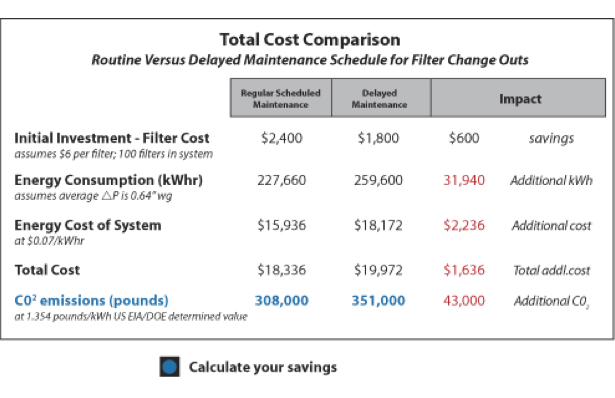
News
Air filtration & energy costs – cutting your unnecessary losses
One item that comes under scrutiny among facility managers looking to reduce expenses is the HVAC system. It may seem logical to save hundreds or thousands of dollars per year by reducing the frequency of air filter change-outs, or by downgrading to a lower-priced filter. In fact, the small amount of money saved by reducing air filter purchases or by purchasing lower-priced (and lower efficiency) filters pales in comparison to the energy and operating costs saved via robust air filtration maintenance.
February 10, 2010 By Ron Cox
HVAC Expenditures: Myths vs. Facts
Effective air filtration provides the primary defense for building occupants and HVAC equipment against indoor air pollutants. It also plays a role in the energy consumed to operate the HVAC system.
Myth: Delaying filter maintenance (i.e., change-outs) will save money.
Fact: While purchasing fewer filters may reduce initial expenses, delaying filter change-outs causes the filter to run more days at peak energy usage. It doesn’t take long for peak usage cost to offset savings in the filter price (Figure 1). That’s because energy use is the largest operating cost in air filtration, accounting for 80 percent of the filter’s lifecycle costs.

The energy used to operate filters is directly proportional to their airflow resistance (Figure 2).

The more resistance (due to clogged filters that aren’t changed as frequently as needed), the more energy is needed to push air through the filter. Resistance typically increases as filters remove more contaminants from the air. This filtration is essential for air quality and protection of HVAC equipment, but it comes at a high cost when filter change-outs are delayed (Figure 3).

Myth: There is little economic incentive to upgrade an air filtration system.
Fact: Some commercial and institutional buildings still use pre-WWII air filtration technology – panel filters, sometimes called “throw-away” filters.
For years, it was believed panel filters provided adequate filtration to keep HVAC systems running efficiently. However, a recent study found panel filters do not provide adequate protection to HVAC equipment, allowing for particle deposits to build on fans and heating/cooling coils, a problem known as “fouling.” Fouling greatly reduces airflow through the HVAC system and prevents heat transfer in the coils, which can increase energy costs.
Myth: Air filtration is not in my budget.
Fact: In many cases, one department (and budget) is responsible for purchasing air filters and filter service contracts while another is responsible for energy expenditures. The problem with this is that the filter purchaser can innocently make a costly decision for the enterprise by choosing filters without considering their energy consumption and system operating implications.
Reducing HVAC-related costs
There are three important factors for air filter maintenance and reduced operating and energy costs: proper filter change-out frequency and installation, upgrading from panel filters to pleated filters, and choosing a filter with a lower resistance to airflow.
Proper filter maintenance and the appropriate filter change-out frequency are crucial to keeping HVAC ductwork clean. The goal of filter installation is to avoid bypass air (air that does not go through the filter), which occurs when filter media is not properly sealed in the filter frame, when filters are not properly installed and gasketed in filter racks, or when air handler doors and ducts are not properly sealed. Bypass air can cause contamination in housings, coils, fans and ducts and can increase system operating costs. Fouled heat exchangers have diminished heat transfer performance and increased pressure drop, leading to significantly increased energy use and decreased heating and cooling performance. Bypass air can also decrease a filter’s performance and negatively affect IAQ.
Pleated filters offer advantages over “throw-away” panel filters. Upgrading from panel filters to pleated filters saves money thanks to decreased routine maintenance and energy costs. Because panel filters allow HVAC system components to become dirty, operating efficiency decreases and energy costs to operate the inefficient system can increase. The small amount saved by purchasing a lower-priced panel filter can be offset by even a slight reduction in the system’s operating efficiency.
One of the easiest ways to reduce HVAC-related energy costs is to switch to a filter with a lower resistance to airflow. When filters have a lower resistance to airflow, the HVAC system motor consumes less energy.
For example, a 0.05” water gauge (WG) reduction in a filter’s initial airflow resistance can reduce energy costs by up to 3.5 per cent or about $7 per filter, while a 0.20” WG reduction in a filter’s initial airflow resistance can reduce energy costs by up to 10 per cent or about $28 per filter. While an energy cost savings of $28 per year may not sound like a lot, keep in mind that those cost savings are per filter, not for an entire HVAC system.
Because energy costs are the largest component of an air filter’s lifecycle cost, it is imperative to look beyond the purchase price of filters when seeking to reduce their overall costs and instead look at the initial and sustained airflow resistance of different filters.
Ron Cox, CAFS, is Market Manager, Kimberly-Clark Filtration. To compare operating and energy costs relating to various filters, consider using an interactive cost-savings calculator like the one found at www.kcfiltration.com.
Print this page